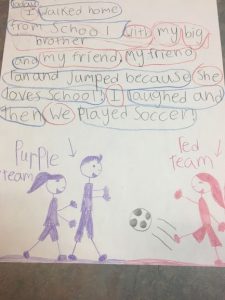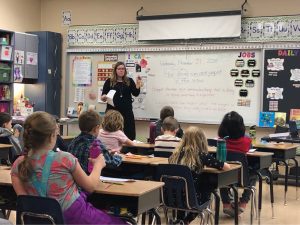In my placement this week I decided to tackle an English Language Arts lesson around the topic of sentence structure. I was very excited to have the opportunity of doing an ELA lesson because it was my favourite subject all throughout my years in school. Even with my excitement, I was quite nervous and overwhelmed with the important task in front of me. When being a pre—service teacher it can be difficult to grasp an understanding of where students are at as well as to have a good sense of where to take the students next since you only see them once a week. I knew my grade two friends had already had experience writing complete sentences and they were fully capable of telling me the components of a proper sentence, so I decided to take them a set or two further.
For this lesson I introduced the terms of subject and predicate which are used when writing a complete sentence. My students were aware of the definition of a noun and seemed intrigued to learn that the parts of there sentences had names to classify the purpose of that sentence portion. A subject is the someone or something in a sentence whereas the predicate is the action that the sucject is doing. I provided a few examples on the board as well as we did an online quiz where two sentences were read aloud and the student had to tell me which one they thought was the complete sentence. We then took these statements and talked about what was needed (subject or predicate) to help the sentence make sense. The students were really engaged with the online resource and I was impressed to see how quickly most students were beginning to understand the concept of subjects and predicates.
The grade twos were then given paper strips with different examples of subjects and predicates. I asked my students to work together in pairs to try and create three different sentences by using the offered word suggestions as well as adding their own words to help the sentence make sense. Once the students had their three sentences they were to choose one sentence and tell me a story about what is happening before, after, or during that sentence. The students were to write a 4-6 sentence paragraph about their chosen sentence. Once each student had their own completed paragraph they were to switch papers with their partner and circle all the subjects and underline all the predicates they could find in their partners paragraph.
Phew! Now looking back and reflecting on the lesson I quickly realized that I was asking and expecting way too much from my students in one single lesson! All the tasks I asked my students to complete could have easily been separated into two lessons and I wish I had come to this realization sooner. During the lesson I struggled to see that my students were rushing through each task just trying to finish. The students were not taking the quality time I was hoping for to engage with the new concepts in a single sentence first before trying to differentiate subjects and predicates within an entire paragraph. Even with such daunting tasks my grade two friends did an incredible job of staying on task and doing their best to participate in each part of the lesson.
I have learned from this lesson that I need to be more aware of my students engagement in the lesson to be able to accomodaate to the students progressive learning process with new content. Being able to adjust a lesson when it is not going exactly as planned is a very important concept to become comfortable with as a pre-service teacher. I really appreciate my students willingness to tackle so many steps at once and I still genuinely enjoyed my first experience teaching an ELA lesson. When given the choice by my co-op I chose to teach another ELA lesson next week to take what I have learned and apply it to next week’s success!
To see Personal Development Plan for this week’s lesson click here!
Student work:


Till next time,
Miss Hansen

